If you’re looking to create a home to protect your fruits, veggies, flowers and everything else, but lack the yard space or land to do it, we’ve got the solution: indoor greenhouse.
To make an indoor greenhouse, first decide on the size and design you want, which depends on what you’ll grow. After constructing the greenhouse, place it in a location where it will get sufficient sunlight (or use grow lights). Finally, set up any optional supplies you’d like to include and start planting.
While it’s true that there’s no such thing as too many houseplants, maybe it’s time to add in some variety to what you’re growing. An indoor greenhouse is just the way to do it.
Why Build an Indoor Greenhouse?
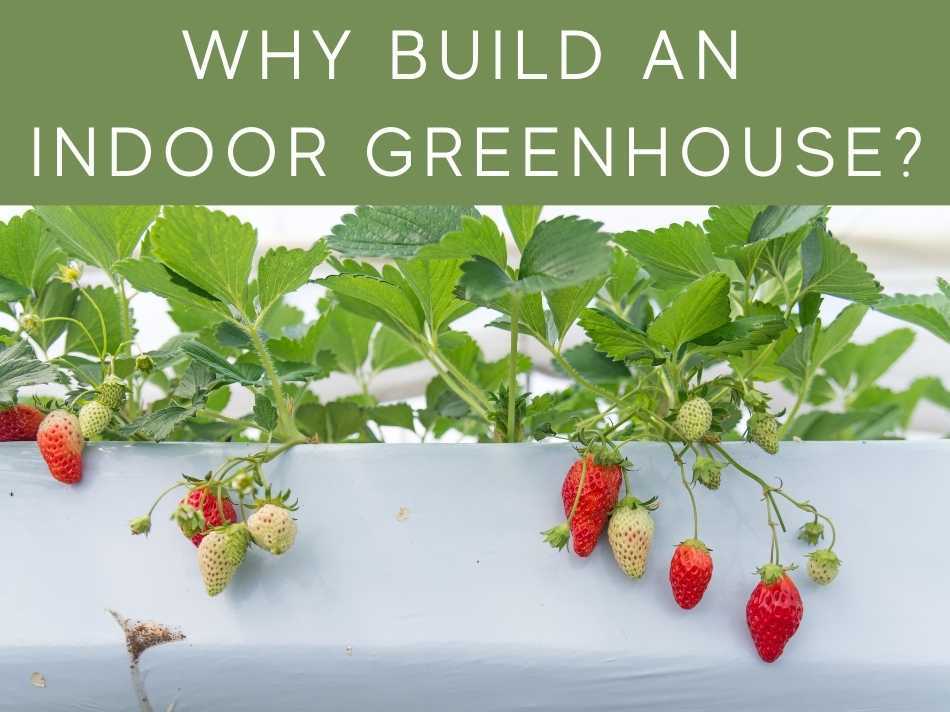
Indoor gardening has really started to make a comeback. Not everyone has the land requirements to operate a whole garden, but, as it turns out, you don’t really need it to grow crops well.
For those who are cramped into a tiny apartment (city life, am I right?), adding an indoor greenhouse is a simple and fun DIY project that will give you a ton of benefits. You get to watch your plants grow and can make adjustments as needed. It can be really nice to have them all within arm’s reach.
Adding an indoor greenhouse greatly expands the number of plant types that you can have inside. Houseplants are awesome, but they can stand to share some space.
And sometimes, even if you have the land requirements, other complications can get in the way of a functioning garden. Maybe the soil is less than ideal, or the climate in your area always seems a moment away from burning your veggies or freezing your flowers.
Or maybe there are some particular plants that you want to grow that are just a little more high-maintenance – I’m looking at you, orchids.
In any case, if you can control the environmental conditions, you’re more likely to have a successful growing season. With an indoor greenhouse, you’re the one in control. The set-up cost is relatively cheap, and the amount of maintenance needed is pretty low, too.
With a full-size, freestanding greenhouse, you can still get those nasty issues like plant diseases and pests, and might not notice at first. You’re much less likely to have those kinds of problems with an indoor greenhouse, and on the off chance that you do, you’ll probably see it immediately.
Not to mention, there are a lot of opportunities to make your indoor greenhouse particular to the plants that you want to grow, and the stylizing options are endless. We’re not just building a fully functional plant haven here – we’re stepping into interior decorating.
Best Plants for an Indoor Greenhouse
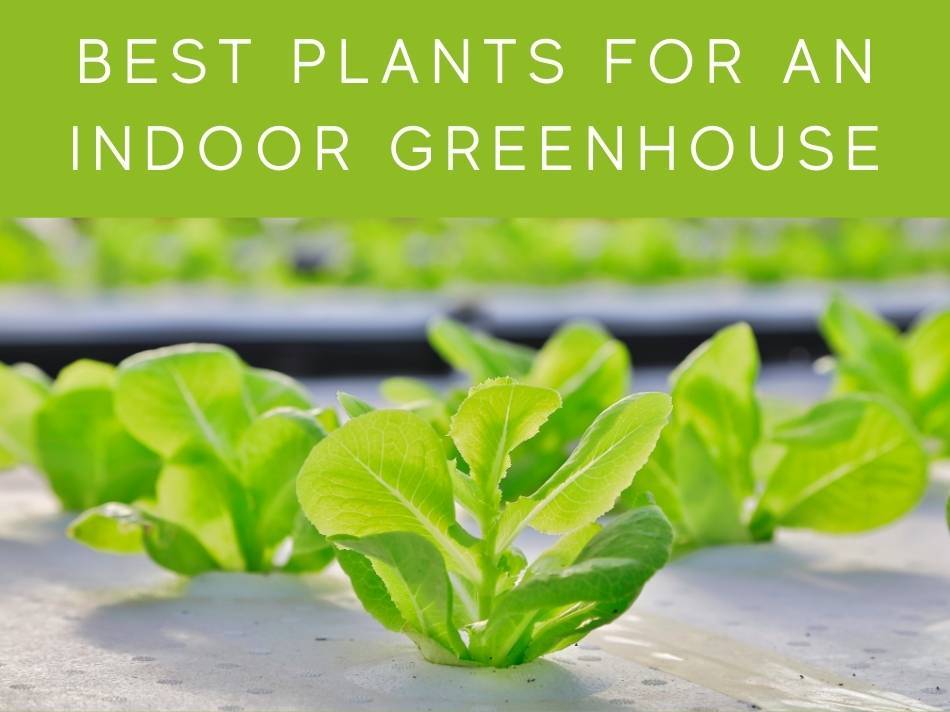
By making an indoor greenhouse, you greatly expand the variety of plants that can be grown inside. You don’t have to be limited to just aloe and spider plants.
Even still, some plants are going to grow better indoors than others. Mostly, just avoid the plants that will get really big. Other than that, the sky’s the limit – or, maybe it’s the ceiling. Just remember to plan ahead and make environmental adjustments as you go.
Keep in mind that some fruits & flowers might have special pollination requirements. We’ve got a whole guide on pollinating indoor plants.
Herbs
Herbs will always be a favorite for growing inside. They’re trouble-free and they don’t take long to grow, so you can chop some up and throw ‘em on your food anytime. If you’re just getting started with growing indoors, thyme, parsley, sage, chives, and just about any other herb will make for an easy, yummy start.
Fruits & Flowers
Here we go again with the orchids. With an indoor greenhouse, it might just be possible.
No, but really! Orchids, chrysanthemums, roses, and marigolds can all grow well in an indoor greenhouse, not to mention strawberries, blueberries, and more. When you’re growing flowering plants, though, keep the space necessities in mind before planting. Just because you’re stuck in a small apartment doesn’t mean your plants have to cramped, too.
If you’re into lavender, check out the guide to growing lavender indoors.
Vegetables
Oh yeah, did I mention that your indoor greenhouse will save you money at the grocery store? You can grow your own vegetables inside your home! Onions, kale, leafy greens – in your indoor greenhouse one second and your stomach the next.
Whatever you decide to grow, it’s important that you plan ahead for the space it will need. Spinach isn’t going to develop particularly deep roots, but carrots are going to need some room under the soil.
Like garlic? We’ve got you covered: our how-to article on growing garlic indoors.
Indoor Greenhouse Sizing
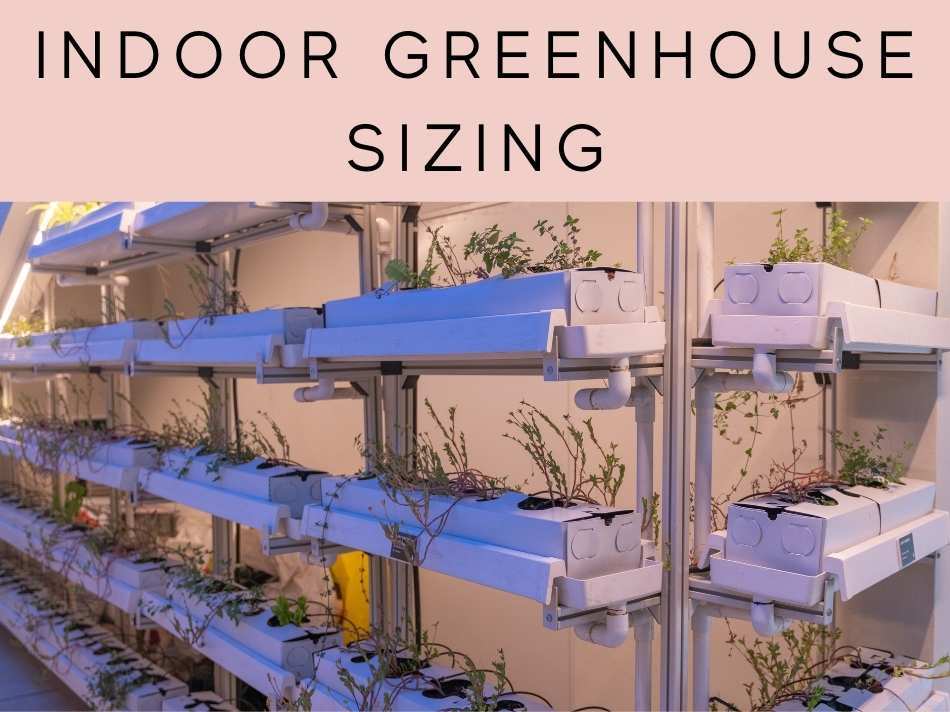
Deciding what size you want your indoor greenhouse to be has a lot of factors going into it, like how much space you have inside, the location you’ll be placing it, and how many (and what kinds of) plants that you’re wanting to grow in it.
If you’re just looking to have a few herbs and maybe some succulents, you shouldn’t need much space at all. On the other hand, if you’re wanting a lot of variety or plan to include some leafy greens or large flowering plants, you’ll need to account for those size differences and strategize accordingly.
You should also think about what layout you’re looking to have. Do you want more of a lengthy, box-like structure that mimics a garden bed, or would you prefer a taller, shelved unit? Mobile or stationary? Decisions, decisions.
If you want to stick to the tinier end of the size spectrum, you can build your mini indoor greenhouse around a small, 5” x 5” grow tray. If you have a larger area in your home that you’re looking to fill, you might consider opting for a five-foot tall, tiered unit.
Keep in mind, you can make your indoor greenhouse as big or as small as you’d like, it’s all yours to customize. Let it take up an entire room, or just a little counter space. If you live in an apartment, you can check out the how-to article for making an indoor greenhouse for your apartment.
Materials: What to Build Your Indoor Greenhouse Out Of?
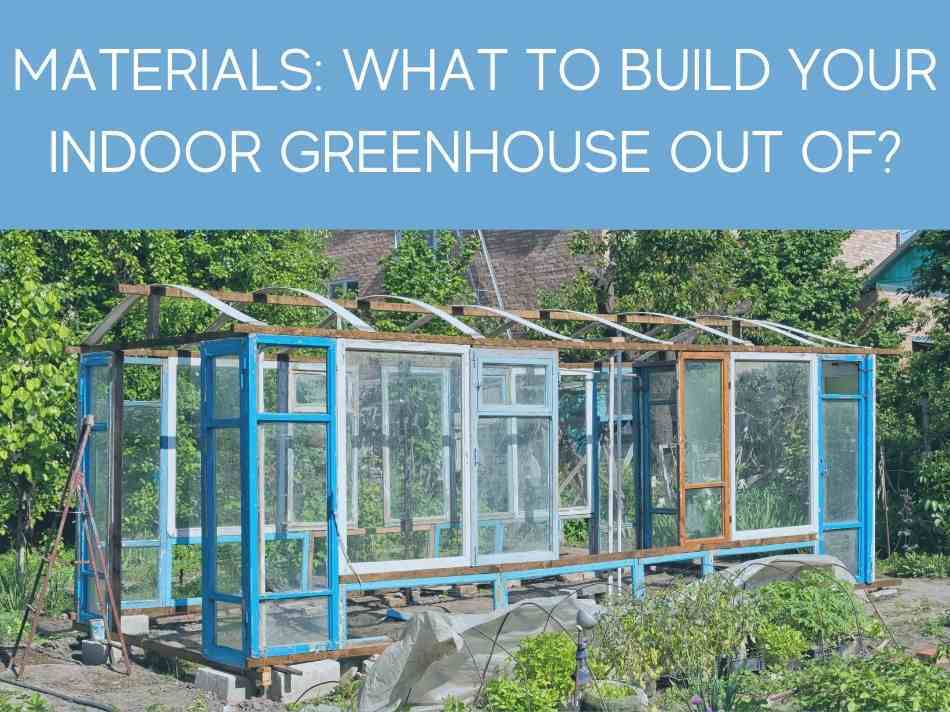
And we’re not done making choices yet. Once you’ve got a general idea of the layout and size you want for your new indoor greenhouse, you have to pick out the material you’re going to use to construct it.
Frame
For now, we’re just going to assume that you’re building a regular greenhouse except, you know, miniature. Later, we’ll mention some more eccentric and unique ways to build indoor greenhouse with less traditional materials.
When it comes to the frame, you’ll need something sturdy so that you won’t have to worry about the whole thing falling apart. The idea is to keep the plants and potting soil on the inside of your greenhouse – and not on the floor of your home.
Like always, you’ve got a selection to choose from.
Wood
The first option is to use wood to build the frame of your indoor greenhouse. This can be done really well and look super nice in your home. It’s not particularly difficult to cut or shape or to assemble into the frame shape you want.
Wood is also a good option for a greenhouse because it insulates well. However, if there’s too much humidity, there’s always a chance that the wood will start to rot and decay – and avoiding rotting wood is, like, Interior Decorating 101. You can avoid this unfortunate scenario by getting treated wood.
PVC pipe
Another simple and low cost route is using PVC pipe. This will make your DIY project a breeze, because it’s very easy to put together. Unlike wood, you don’t have to worry about the humidity warping the structure.
PVC pipe seems like a great option – and it is – but there are still drawbacks. PVC pipe isn’t going to be quite as strong as metal, so, if you want a lot of tiers to your indoor greenhouse, it might not be the best choice.
Another problem is that PVC pipe starts to lose its strength by being exposed to sunlight for a long time. You can see how, for a greenhouse, this can be problematic.
Luckily, it’s a pretty quick fix. When you buy the PVC pipe, just make sure that it’s UV-protected, or you can apply primer and paint the pipes yourself. A minor inconvenience just became another way to personalize your indoor greenhouse.
And, really, you were probably going to have to paint it anyway. What if the PVC pipe you got was classic white and your walls are painted eggshell? That would clash.
For more detailed instructions on building a PVC greenhouse, you can check out this article.
Steel
Galvanized steel is another great choice, because it’s strong and not too expensive.
By the way, “galvanized” means that the material has had a layer of zinc applied to it in order to prevent rusting, so you don’t have to apply paint or sealant in this case.
The downside of using steel is that it’s not going to be as easy to cut as, say, wood. And because it’s very strong and durable, it’s also pretty heavy. Depending on the picture you have for your indoor greenhouse, the drawbacks of steel may outweigh the pros.
Glazing / Covering
Once you’ve got your frame material picked out, you need to think about the covering to use. As with a regular greenhouse, this is important because it affects how much light is going to get through to your plants.
Glass
A glass covering is very traditional for greenhouses. There are some good reasons to opt for glass: it’s easy to maintain, it’s not going to wear out, it has a pleasing appearance, and it allows a lot of light to pass through it and get to your plants inside.
However, it’s also not the cheapest covering option, and installing it yourself can be a pain. The biggest downside to having glass, though, is that it can break easily. If you know that your indoor greenhouse will be kept out of harm’s way, it might just be the best choice. But, if you have rowdy animals or playful kids…
Well, you probably skipped ahead after reading “glass.”
Fiberglass
Like regular glass, a fiberglass covering for your indoor greenhouse will allow a lot of light to pass through it – at least, it will at first.
Fiberglass is lightweight and strong, but, after about ten years, it will start to discolor. At that point, you just need to apply a new coat of resin. This is a bigger concern for full-size greenhouses, and not as much of an issue for smaller, indoor greenhouses.
Film plastic
Plastic coverings are very commonly used for indoor greenhouses. There are different kinds of plastics, and the amount of light that gets to the plants in your greenhouse depends on which type you use.
Film plastic covers are the cheapest option, but they also require more upkeep and replacements. On the plus side, they’re fairly good at trapping heat.
Other Options
What we’ve mentioned so far are the more conventional options. If these materials sound suitable to your tastes, you can get the supplies yourself and get to work on constructing it, or you can order a kit online that’s closest to the design you’re wanting and assemble that.
But, there are few more choices worth considering that are a little further afield from just a miniature version of a greenhouse. If you’re interested, you’ll surely be able to find a DIY video for making an indoor greenhouse out of just about any material, including plastic bottles, picture frames, CD cases, egg cartons, and more.
Environmental Controls
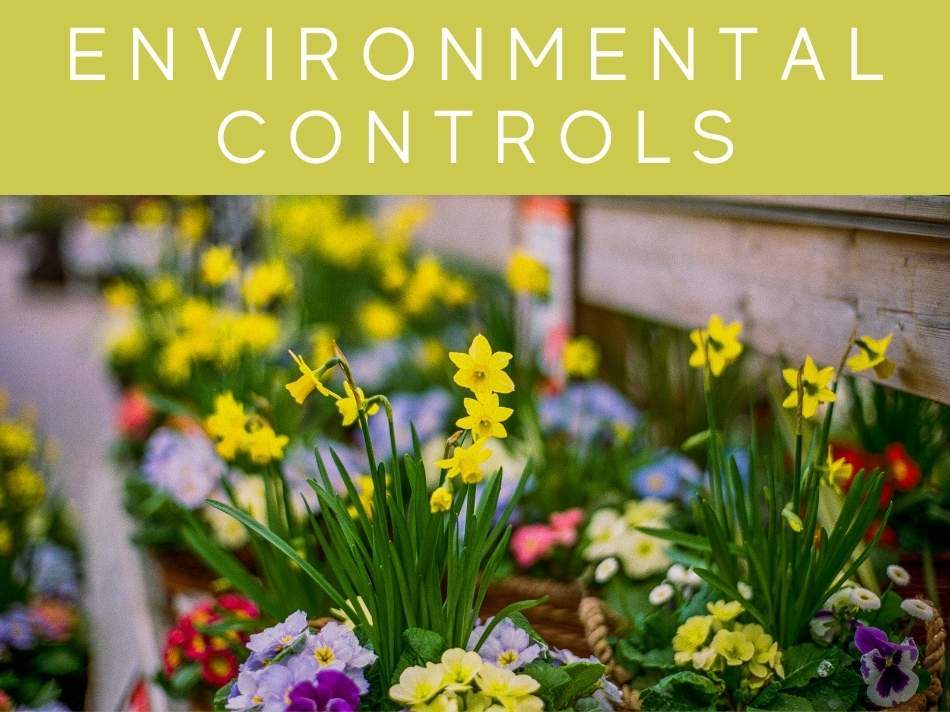
You can only do so much to protect your plants outside, but inside, you can make it the perfect plant paradise.
Sunlight & grow lights
Sunlight is always the ideal light source for plants, so it’s important to place your indoor greenhouse in a spot where it will get as much sunlight as the plants you’re growing need. Grow lights are a good supplement to sunlight, but won’t serve as an outright replacement for it.
You should consider getting grow lights for the winter, or if you’re growing plants that require a lot of light. If you get grow lights, add a timer to the shopping list so that you can regulate how long they’re on/off for and don’t accidentally end up cooking your veggies before you even take them out of the greenhouse. Some types of grow lights can get hot.
For more details on grow lights, you can check out more detailed articles on whether LED grow lights work, and how far away should led grow lights be from plants.
Temperature
Speaking of heat: generally, plants can handle a temperature range of about 65-75°F, give or take about 10 degrees at most. Depending on the type of plants that you’re growing, this range may be smaller, or shifted towards one end of the spectrum. Check out the specific conditions ideal for your plants.
While your home is almost certainly within that temperature scope, being able to control the cooling or heating of your greenhouse is really helpful to ensuring successful plant growth. Plus, the greenhouse will trap heat, making it warmer on the inside than it is in your home.
For this reason, it can be really handy to have a thermometer. If you find that it’s getting too cold inside the greenhouse, you can add in a tea-light or a small electric heater. Also, since most plants grow best when the nighttime temperature is 10-15 degrees lower than it is in the daytime, you can get a fan to help with lowering the temperature as well as increasing air circulation.
Humidity
Even indoors, the seasonal changes will affect the environment, including the humidity. To keep your plants from losing leaves or turning brown from low humidity levels, consider getting a humidifier. Or, just remember to mist the plants at least once a day, maybe more.
Water & Nutrients
As per ushe, the soil should be moist, but not too soggy. Since your indoor greenhouse will likely be within a few steps at all times, you can keep an eye on your plants and water as you see fit. Or, if you want your indoor greenhouse to be more or less self-sufficient, you can get a system to automatically water the plants for you.
Unlike in the great outdoors, where the soil is practically limitless and plants can feast on the bounty of nutrients, there’s a finite amount of minerals for your plant to soak up when kept in a greenhouse.
To combat this predicament, you’ll need to add some organic fertilizer or compost in small amounts, but repeatedly throughout the year. Once a month ought to do it during early growth, then you can start to use less as the plants become mature.
Supplies Needed
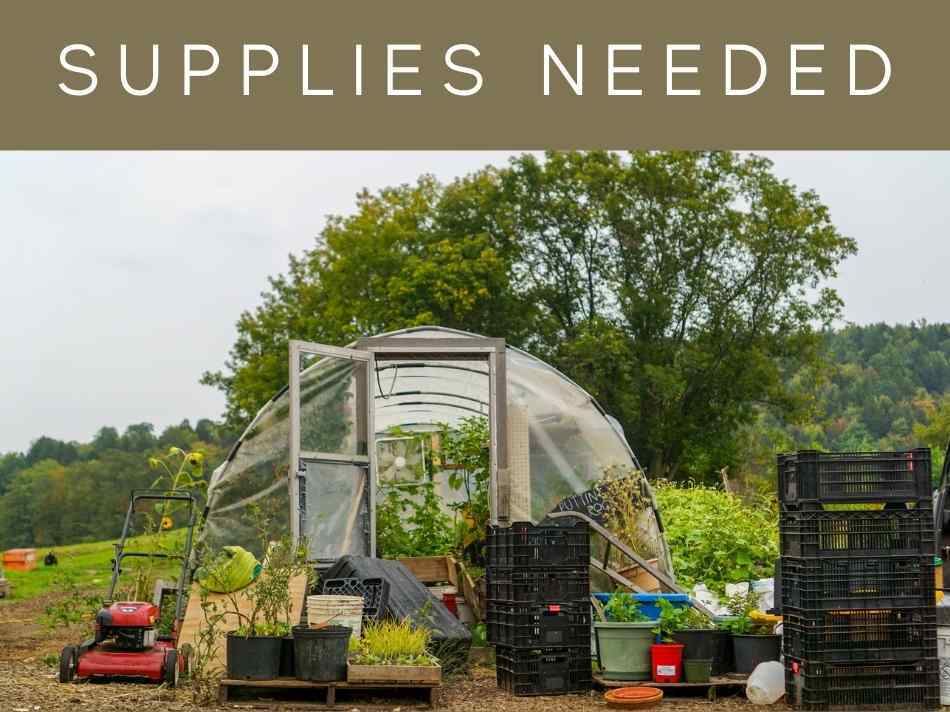
In addition to the frame and covering materials needed to build the greenhouse, there are a few supplies that you’ll need, including: pots or trays, soil, fertilizer, and seeds.
After you’ve got those bare essentials, you can consider some of the more optional additions to help you out.
- Grow lights: These can be helpful during the winter months, when you’re not getting a lot of sun, especially inside. Or, if you want to grow plants that prefer high light intensity, grow lights can provide good support to the sunlight.
- Thermometer: It’s hard to tell exactly what the temperature is inside your greenhouse, because it might be really good at trapping heat or maybe it’s not as good of an insulator as you thought. In any case, it’s a good idea to get a thermometer to tell you for certain whether it’s staying within the range you’re looking for.
- Heater: And if you see the temperature dropping too low, add a small electric heater or warming crate pad.
- Fans: Fans will lower your indoor greenhouse’s temperature, as well as provide some much-needed air circulation.
- Hygrometer: As with the temperature, it can be hard to tell if the humidity level is where you want it to be…until it’s a little late, and your luscious greens are starting to look more putrid brown. You can avoid that by adding in a small hygrometer.
- Watering system: By adding a misting system or complete watering system, you lower the daily maintenance required for your indoor greenhouse, and you can rest easy knowing that it’ll be taken care of if you have to leave your home for a couple of days.
- Soil probe: Even when you’re planting outside, you need keep an eye on the soil, especially the pH and moisture levels. Since there’s not a ton of soil that these plants will be grown in, you’ll have to consistently add fertilizer – in small amounts of course, but more often than you’d need to for a garden. So, to keep from adding too much, a soil probe can be a helpful addition.
Cost
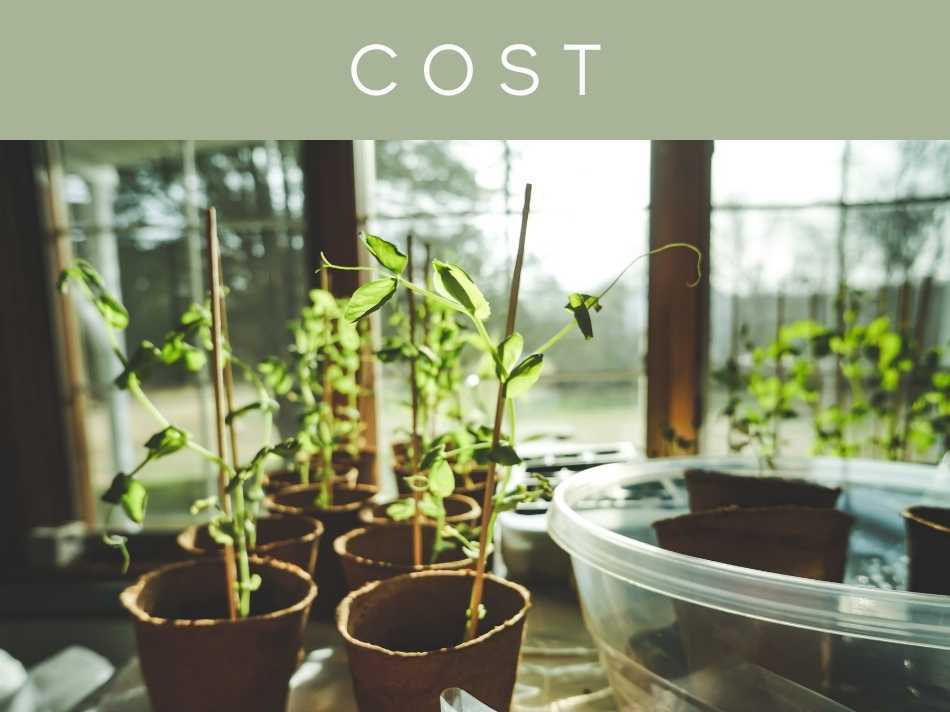
Okay, this is probably the part where you’re wondering if all the wonderful greens you’re going to be growing are actually worth all the green it might cost you.
As mentioned before, the majority of this stuff is helpful but entirely optional. Building an indoor greenhouse from scratch doesn’t have to cost any more than you want it to.
On the low end, people have put together reasonably sized indoor greenhouses – enough to house plenty of flowers and herbs – for less than $10. If you were wanting to buy a kit, there are complete, 4-tiered indoor greenhouse kits for just over $30.
Even the optional stuff is pretty cheap, since anything you would get would be a very small version. Hygrometers are about $5, the grow lights you’d get for an indoor greenhouse would be about $20.
Since this DIY project was made to be relatively small, you don’t need to worry too much about the final bill – even if it looks like the shopping list is adding up.
Getting Started
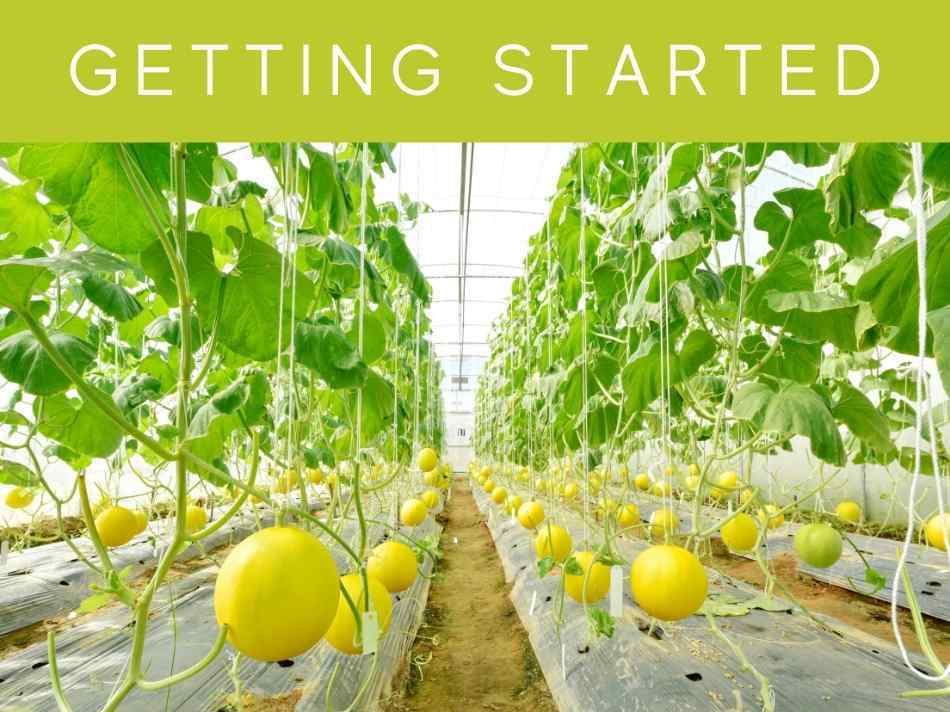
Before setting anything up, you need to make some plans. Decide what and how much you want to grow, since that will determine the size of your indoor greenhouse. Next, find a spot in your home that you can place it so that your plants get plenty of warmth and sunlight.
Once you’ve got a layout and size in mind, you can get the supplies for the frame and covering, and start constructing. After you’ve got it put together to your specification (and posted the awesome pictures of your DIY project to every platform), place your grow trays or pots inside the greenhouse, making sure that there are holes for drainage.
Next, simply add growing medium, plant the seeds to the necessary depth, and add water! It’s recommended that you use seeds rather than cuttings to minimize the likelihood of bringing creepy-crawlies into your house. In no time, you’ll have a whole garden tucked away in your home.
Finally, install any of the optional supplies. Make use of this early time to find out any adjustments (temperature, humidity, etc.) you should account for.
Maintenance
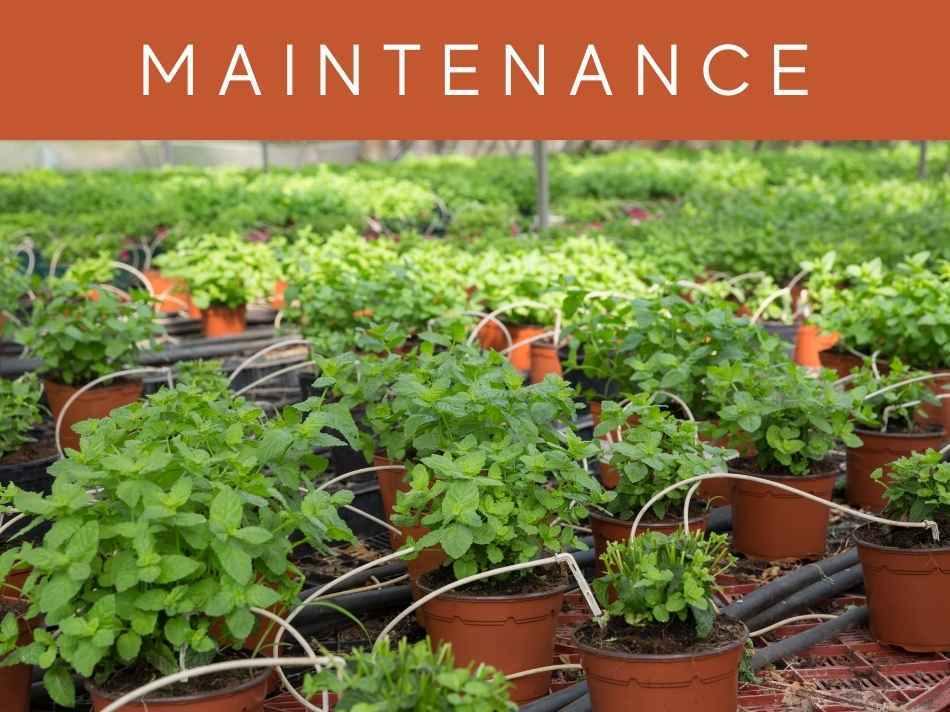
While you’re certainly not going to have to perform as much maintenance as you would for a full-size greenhouse or even for a garden, there are still some tasks to take care of so that everything can operate smoothly and your plants can grow happily.
Cleaning & Disinfecting
Assuming you don’t have a potting mix catastrophe on your indoor greenhouse, you only need to worry about cleaning the outside around once a month. However, this depends on what type of material your covering is made of. For the interior, cleaning once every couple of months should be fine.
Glass and fiberglass don’t tend to get dirty all that fast, but plastic coverings do. And besides being an eyesore, this can block light from getting to your plants. Use a warm, soapy water and a sponge to clean glass. For plastic coverings, you can try to clean them this way, but it’s better to just replace them.
Every couple of months, take out all the pots and trays to fully clean and disinfect the inside. Throw out any dead leaves or weeds, and apply hydrogen peroxide or another disinfectant to the space inside. We’re trying to grow happy, healthy plants – not mold. This is a good time to clean and disinfect any tools or supplies you have, as well.
Decluttering
With a small space, you need to constantly keep an eye on the clutter state. If your plants start to take up more room than you were anticipating, that’s cool – but also, make sure it’s not going to cause problems.
If there are any pots or trays that you’re not going to use anymore, throw ‘em out. Remove weeds and dead leaves as you come across them, and trim back excessive leaves as needed. Don’t let any singular plant hog all the air and sunlight. This is a shared space.
Similar Options to an Indoor Greenhouse
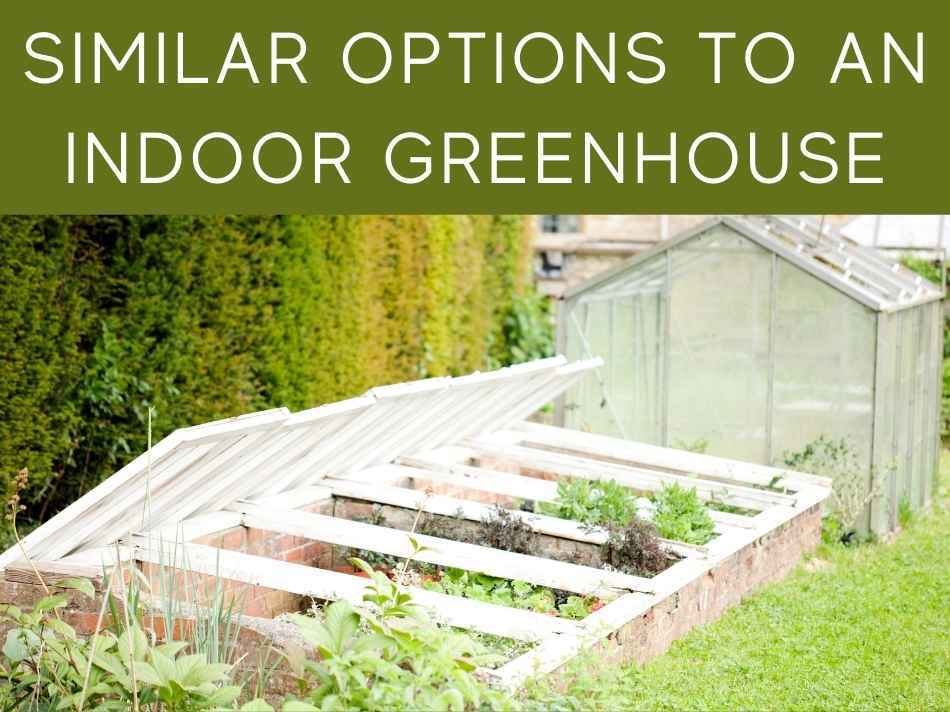
Grow Tents
A grow tent is actually a special variety of an indoor greenhouse. As the name suggests, it’s made of a canvas exterior. On the inside, there’s usually reflective material which spreads the heat and light evenly throughout the space.
While they can be used for soil gardening, they’re most commonly used for hydroponic systems. Grow tents are entirely independent of the climate and season. Typical indoor greenhouses still rely on a certain level of sunlight exposure, but grow tents are enclosed and covered, powering the plants with only grow lights.
As with regular indoor greenhouses, grow tents come in all different sizes, but another great benefit is that there’s very little set-up required. And, since you don’t need access to sunlight for grow tents, they’re great for more obscure places like a garage or closet. As long as they have a ventilation system, you can put a grow tent anywhere.
Cold Frames
Acting as sort of a mini greenhouse, cold frames are used mainly to protect your plants from the coldest months of winter. Cold frames, though, don’t have all the environmental controls that greenhouses are known for.
So, if you need all those environmental controls, these might not be all that useful – but if you just need some temporary weather protection, these might just be the way to go. They can also be used to germinate seeds that would have a hard time growing in a particular region.
Cold frames are typically built outdoors, and, by trapping heat the same way as a greenhouse, they can create a space that’s up to 10 degrees warmer than the outside temperature. Their height ranges from about 2-3 feet tall, and they usually have a length between 5-10 feet, but, as always, it’s up to the owner.
If you do have garden space and need to protect your plants but don’t want to go through the hassle and constant upkeep of a free-standing greenhouse, cold frames are another option to consider.
Terrariums
Whereas a greenhouse is almost always used for growing at least some edible plants, terrariums are much more commonly used for decoration. Like an indoor greenhouse, terrariums are typically made of glass and create an enclosed system, but a terrarium will house things like ornamental plants and mosses.
This also allows terrariums to be smaller than even the smallest indoor greenhouses. At the minimum, all you need to start a terrarium is a mason jar or bottle. From there, you can add a layer of pebbles to allow for proper drainage, then a layer of moss, and finally the potting mix.
Compared to indoor greenhouses, the environment of a terrarium is much more humid, so you should avoid succulents and cacti (cactuses? cactopods?). Another difference is that, with an indoor greenhouse, you’re going to be growing plants from seeds, whereas, when you set up a terrarium, you usually transfer a slightly grown or fully mature potted plant to the new location.
If you’re just looking to exercise your green thumb a little, starting a terrarium is a low-maintenance, decorative way to do so. If you’re wanting some herbs or veggies, though, stick to indoor greenhouses.
Related Questions
What do you need to build an indoor greenhouse?
The minimum requirements for setting up an indoor greenhouse include: material to build frame (wood, metal, PVC pipe), material for covering (plastic, glass), potting mix, pots/trays, and seeds.
Some optional supplies to include are: grow lights, a thermometer, a heater, fan, hygrometer, etc.
Which plants to grow in an indoor greenhouse?
Greenhouses are meant to be able to grow anything, and an indoor greenhouse is no exception. The only real limitation on what you can grow is determined by the size – if it gets too big, it’s not a good option for a greenhouse, because it might start to get tangled with other plants and cause some problems.
Since your indoor greenhouse will have its own environment, you should consider growing the plants that have similar ideal conditions together.
Indoor greenhouse system
With an indoor greenhouse, you can grow just about anything you could grow outside within your own home. To set up an indoor greenhouse system that requires very little care, you can add grow lights, temperature controls, and humidity controls to maintain the ideal environment. You can construct a more traditional “mini greenhouse” or opt for a grow tent.

